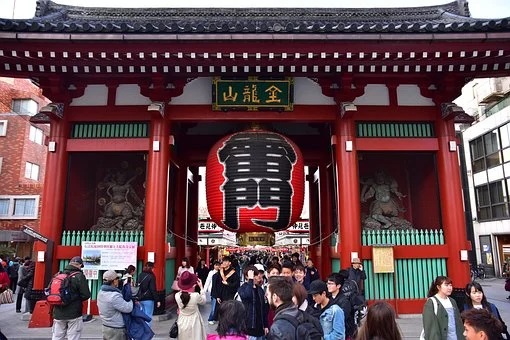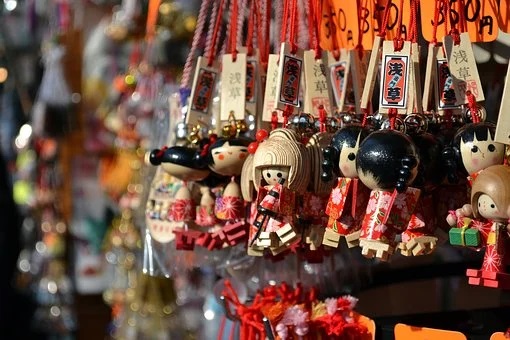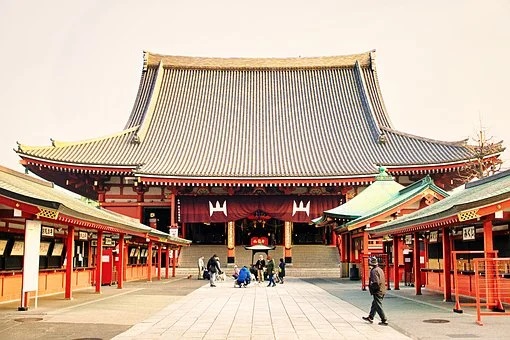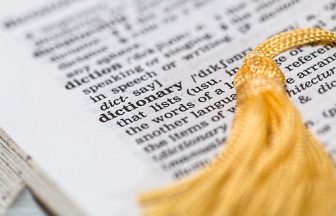Hello! Welcome to Our Site.
みなさん、こんにちは! 私たちのサイトへようこそ。
Let’s talk about “Asakusa.”
Do you know where Asakusa is?
浅草について紹介します。あなたは浅草がどこにあるかご存じですか?
It is near the center of Tokyo, the capital of Japan. In Asakusa district there are Sensoji-temple, Kaminari-mon, Nakamise and so on. It is one of the most famous sightseeing spots both Japanese people and foreign tourists visit throughout the year.
浅草は日本の首都、東京の中心近くにあります。浅草には浅草寺、雷門、仲見世などがあります。浅草は日本人にも外国からの観光客にも、一年を通して最も有名な観光スポットです。
Now let me introduce you Asakusa.
それでは浅草について紹介します。
#2 浅草の歴史・見どころ・旅ガイド

東京の下町で有名な浅草は、日本でも有名な観光スポットです。浅草寺の門前にある「雷門」の巨大な赤い提灯が見所です。浅草寺まで続く仲見世通りでお土産を見つけましょう。
それでは、浅草を紹介します。
About Asakusa|浅草とは
Asakusa is a famous sightseeing spot in Tokyo, which is reminiscent of the Edo period. This district has been flourishing as a temple town of Senso-ji, the oldest and the largest temple in Tokyo. Kaminarimon, or “Thunder Gate,” the outer gate of the temple is very famous as a landmark of Asakusa for its huge red lantern. Both domestic and foreign tourists flock to this venerable temple and the shopping arcade called “Nakamise” in the compound, the best place to buy traditional Japanese souvenirs in Tokyo.
浅草は江戸時代を連想させる東京の観光名所である。浅草は都内最古で最大の寺院である浅草寺の門前町として栄えてきた。山門の雷門は巨大な赤い提灯が浅草のランドマークとして非常に有名である。国内外の観光客はこの由緒ある寺院、そして東京で伝統的な日本の土産物を買うのに最適な、境内の「仲見世」と呼ばれる商店街に集まってくる。
History of Asakusa|浅草の歴史とは
Asakusa is the district in the eastern part of Taito Ward, Tokyo, on the west bank of the river Sumidagawa. The district came into being during the Edo period (1603-1867) as a commercial and entertainment area centered on the temple Sensoji, popularly called the Asakusa Kannnon. The Yoshiwara pleasure quarter was once located just to the north. Asakusa still retains the distinctive atmosphere of Tokyo’s shitamachi, with attractions that include the Nakamise and Shin Nakamise shopping arcades and the movie theaters and entertainment halls of the Rokku area. A number of traditional fairs and festivals are held in Asakusa, among them the Sanja Festival.
浅草は東京都台東区東部、隅田川の西岸に位置する地区。この地区は江戸時代(1603-1867)に、一般には浅草観音と呼ばれる浅草寺を中心とする商業地、歓楽街として形成された。吉原遊郭がかつてすぐ北にあった。浅草は、仲見世や新仲見世商店街、六区の映画館、演芸場などがあり、今でも東京の下町の雰囲気を残している。三社祭など多くの市や祭が浅草で行われている。
Point 1|Kaminari-mon Gate-雷門とは

Kaminari-monn (Thunder Gate) is an abbreviation for “Gate of the Wind God and Thunder God,” the full name of the main entrance to Senso-ji. Facing the gate, statue on the right is the Wind God and the one on the left is the Thunder God. The Wind God carries a wind sack on his back, which he opens and closes to make the wind blow and stop. The Thunder God causes thunder by beating the drums on his back. The wind spreads the seeds of grain, and the rain that follows thunder helps them sprout; together they are symbols of an abundant harvest.
「雷門」は浅草寺の正門の正式な名称「風雷神門」を短くした言い方です。門に向かって右側が風神、左側が雷神です。風神は風袋を背負っており、その袋の口を開け閉めして風を吹かせたり止めたりします。雷神は背中の太鼓を叩いて雷鳴をとどろかせます。風が穀物の種をまき散らし、雷が呼ぶ雨が芽の成長を促します。この二神は五穀豊穣のシンボルなのです。
After the gate burned down in a fire in 1865, it took 95 years until the present one was rebuilt by Matsushita Konosuke, founder of the Panasonic company. The huge lantern bears the name of gate, Kamirani-mon, and has a carving of a dragon on the bottom, believed to protect buildings from fire.
1865年に火事で焼失した後、95年たって、パナソニックの創業者、松下幸之助により現在の門が再建されました。「雷門」の名前が入っている大きな提灯の底には、建物を火災から守るとされる龍の彫り物があります。
Point 2|Nakamise-仲見世とは

There are about 90 souvenir shops along the Nakamise, the 250m approach form the Kaminari-mon to the inner Hozo-mon gate. These shops carry just about every type of souvenir covered by tourists from overseas. Many wind up spending most of their available time shopping here, then have to rush to see the main temple hall.
雷門から宝蔵門までの約250mの参道に約90軒の土産物屋が立ち並んでいます。これらの店は海外からの観光客の求めるほぼすべての土産物を扱っています。多くの観光客は、浅草滞在時間のほとんどをここでの買い物に費やしてしまい、本堂の見学が駆け足になってしまうこともあります。
The Nakamise first appeared in the Edo period, when neighbors of the temple who helped clean the precincts were granted permission to open shops here. After the Meiji Restoration, the government of Japan took ownership of the land, but in 1911 it was returned to Senso-ji.
仲見世は江戸時代に始まりました。境内の掃除を手伝った近所の人たちが寺から出店営業の許可を得たのが始まりです。明治維新後、土地の所有は明治政府に移りましたが、1911年に浅草寺に返還されました。
Point 3|Senso-ji Temple-浅草寺とは

Senso-ji Temple has a long history and has been popular until now. Many Japanese also visit this destination. You can enjoy shopping and trying out different eating places. Now let me introduce you Senso-ji Temple.
浅草寺は歴史が長く過去から現在まで人気があるお寺です。日本人も多く訪れる観光名所であり、ショッピングや食べ歩きができる所です。それでは浅草寺について紹介します。
Point 3-1|History of Senso-ji Temple-浅草寺の歴史とは
Together with Meiji-jingu shrine, Senso-ji temple is Tokyo’s most popular destination. The oldest Buddhist temple in Tokyu, it is unique in having been founded by commoners, not the aristocracy.
浅草寺は、明治神宮と並んで都内で最も人気のある目的地です。都内で最も古い寺で、貴族ではなく庶民により創建されたユニークな歴史があります。
Its history starts in 628, when legend has it that two brothers fishing in the Sumida River brought up a tiny (5.5 cm) golden statue of the Bodhisattva Kannon in their net. To enshrine the statue, the villagers built a small sanctuary at the foot of Komagara Bridge on the river.
その歴史は、628年に隅田川で漁をしていた二人の兄弟の漁師の網に約5.5cmの小さな金の観音菩薩像がかかったという言い伝えに始まります。その像を祀るため村人たちは小さなお堂を隅田川にかかる駒形橋の袂に建てました。
But 17 years later, the priest Shokai Shonin had a dream in which he was told that the statue should be kept hidden from the view. Since then it has never been shown to the public. According to the records of the temple, when the Meiji government ordered the separation of Shinto and Buddhism in the late 1800s, government officials opened the small shrine and confirmed the statue’s existence.
しかしその17年後、勝海上人がこの像を秘仏にするようにとのお告げを夢で受けました。それ以来、この像は御開帳されたことはありません。寺の記録によると、1800年代後半に明治政府が神仏分離令を発布したときに明治政府の役人が厨子を開き像の存在を確認したそうです。
Point 3-2|Sensop-ji Temple, Now-今日の浅草寺
From the Heian period on, the temple gradually grew with the support of leading samurai warriors. Then, in the early Edo period, it became the family temple of the Tokugawa Shogunate and developed into the largest temple in Edo.
平安時代以降、寺は有力武将らの寄進を受け次第に大きくなりました。江戸時代初期、徳川将軍家の菩提寺となり江戸で一番大きい寺となりました。
Most of the temple, including the Main Hall, was destroyed in 1945 during the Tokyo air raids, but it was rebuilt after the war. Currently, with some 30 million annual visitors, it is most frequented temple in Japan.
本堂を含む寺のほとんどの建物が1945年の東京大空襲で焼失しましたが、戦後再建されました。現在は、年間の参拝者が日本一多い3,000万人という寺となっています。
ASAKUSA:Information|浅草 基本情報
| 名称 | 浅草、浅草寺 |
|---|---|
| 住所 | 東京都台東区浅草2丁目3−1 |
| 電話 | 03-3842-0181 |
| 営業時間 | 開堂午前6時(10月〜3月は午前6時30分) ~ 閉堂午後5時 |
| 定休日 | 定休日なし |
| 拝観料 | 大人 無料 |
| 子供 無料 | |
| アクセス | 最寄駅「東京メトロ銀座線 浅草駅」 |
| バス停「浅草雷門」 | |
| 駐車場 | なし |
| 駐車料金 | – |
| – | |
| – | |
| サービス | なし |
| 登録日 | 2020年3月26日 |
| 更新日 | 2020年5月1日 |
※最新情報は、公式ホームページでご確認ください。
Vocabulary
| reminiscent | ~をしのばせる |
| flourish | 栄える |
| venerable | 由緒ある |
| shopping arcade | 商店街 |
| souvenir | 土産物 |
| commercial | 商業の |
| entertainment | 歓楽 |
| distinctive | 独特の |
| retain | 残している |
| atmosphere | 雰囲気 |
| traditional | 伝統的な |
| abbreviation | 省略形 |
| statue | 像 |
| spread | まき散らす |
| seed | 種 |
| sprout | 芽を吹く |
| carving | 彫り物 |
| carry | (店で)扱う |
| aristocracy | 貴族 |
| small shrine | 厨子 |
Phrase
| bear the name for … | ~の名前が入っている |
| approach from ~ to … | ~から…への参道 |
| symbols of abundant harvest | 五穀豊穣のシンボル |
| spend most of their time available –ing | 利用できる時間をほとんど~に使う |
| the separation of Shinto and Buddhism | 神仏分離 |
One Point Lesson

「見る」|「see」「look at」「watch」の違いと使い方 自然に「見る」こともあり、見ようとして「見る」こともあり、集中して「見る」こともある。英語の言い方を覚えておきましょう。 「見る」|「see」は自然に視覚に映る see は積極的に見る意志がなくて自然に視覚に映ることを表すとき...

「旅行」|「travel」「trip」「tour」の違いと使い方 「旅」には仕事や娯楽もあり、見学や視察もあり、短期や長期の旅もある。英語の言い方を覚えておきましょう。 「旅」|「travel」は仕事・娯楽の長距離旅行 travel は主に仕事・娯楽目的での長距離の旅行を漠然と表すときに使われ...

「場所」を英語で表現するとき「Place・Spot・Location」をどれを使う? 日本語で「場所」と言えば、一つ。 でも、英語で「場所」を表現するときには「place・spot・location」などの単語がありますね。日本語で場所は、漠然とその辺という意味。「場所」と言えば、 ...





